5. E-textiles¶
This week, we talk about E-textiles!!!
At first sight, "E-Textile" recalls me "connected", and it's a such mysterious field that did not attract me so far. As for me, we are already over-connected, and to me, human-beings need to deconnect a lot and find their way back to calm and nature... but I have to admit that it can bring as well such interesting improvements, and help people in their everyday life, like for disabled people, and more globally in the medical research. And that's what we saw on monday, even before the beginning of the class, with the project Lovewear about which I'm talking just beneath in the Recitation part.
So let's dive into E-Textiles, electronics, and make the light blink again on my very VERY OLD souvenirs of physics classes !!!
Recitation¶
This week began with the presentation of WITSENSE, a project about sensible innovation, developed by Emmanuelle Corti and Ivan PARATI. I was absolutely impressed by their work, and in particularly the subject they chose to get into :
sexuality and disability.
Go discover Here to know more about their Lovewear concept
On this same subjects, Dr. Sarah KETTLEY explores the use of e-textiles with mental health patients.
Research¶
As I said, there are lots of artists, researchers or makers, fascinated by the subject. It is a very creative field and so many possibilities are offer when you push your knowledge about it.
Innovation is running so fast in this field, and interest a lot of brands that invest huge amounts on research.
For example, here is an article about Futuristic fibers, and how industry should evolve in its consideration towards fabrics, and see it as a service to create new devices:
"However engrained that is in the industry, the forward-thinking Advanced Functional Fabrics of America wants insiders and consumers to recognize the service that technologically enhanced fabrics can provide. Running tights that illuminate when facing headlights, color-changing garments, cellphone-charging fibers, athletic wear equipped to share real-time physiological data and app-powered trade show bags that share personal information are among the Cambridge, Mass.-based group’s projects. Developing fabric as a service or fabric as software is part of its mission."
“We think high-visibility apparel — for the self-driving future — is going to be important. Imagine you’re wearing a pair of normal trousers in the evening crossing the street, when the lights of a car hit your trousers the lights in the fibers light up. So that vehicle will know there is a pedestrian in front of them. We have these awesome light blue trousers that look like ones you would buy at any store. No one would ever know there are lights in them. They don’t look like a science project,” Hays said.
Example of how E-textiles can be used
In fact, the playground is really infinite : Activities around for children, Projects about helping disabled people, Artistic projects like costumes etc... I've been so amazed to see all the various information and tutos you can find on the subject !!!
-
Turn Signal Biking Jacket
Take a look on that video that has been made during an E-textile SummerCamp. There is a real community work around all experimentation that are done in this field, and you can feel how people have so much fun playing with electricity.
in this page it is SO AMAZING !!!
Glittering artists¶
- Maggie ORTH, Musical Jacquet

Here is a video that shows her incredible work with e-textile:
- David STEARNS, Glitch Textiles,
"One aspect of his work is the transformation of glitch art into woven designs through his concept textile brand Glitch Textiles, founded in 2011. This ranges from visualising raw binary data of applications to writing custom algorithms to generate patterns that can be transformed into tactile and functional artworks. Another venture is the Fragmented Memory triptych of large woven tapestries completed in May 2013 at the TextielMuseum in Tilburg, the Netherlands. This project used digital practices and processes to blur the lines between photography, data visualisation, textile design and computer science." Here the whole article
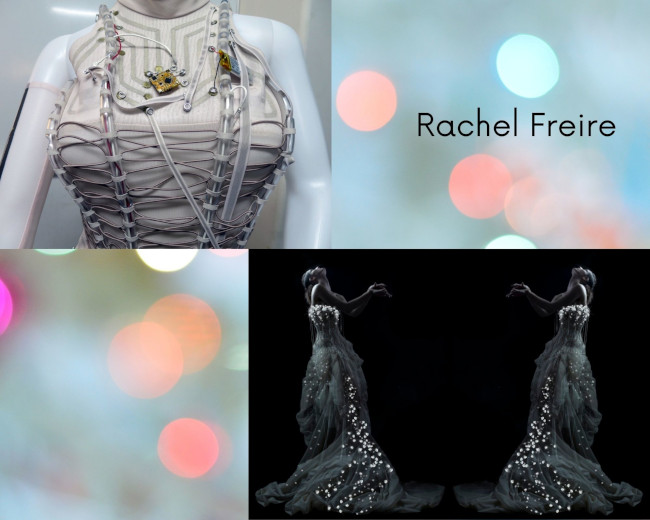
- Irene Polsch : Combining traditional technics of embroidery and knowledge to craft a programmable computer
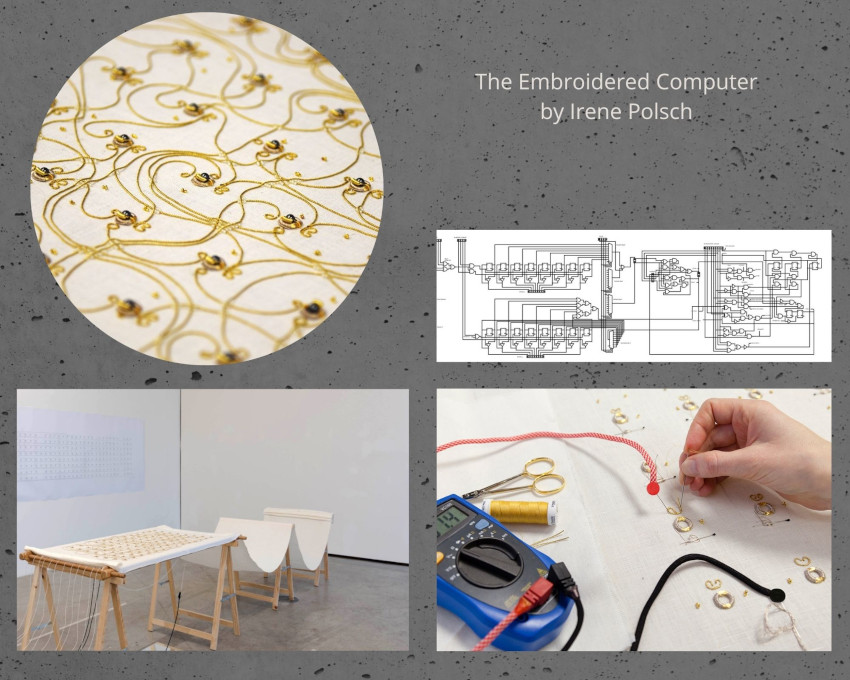
Useful links¶
Here are some of the very usefull web sites, and full of tutorials and information about E-textile:
About materials
Tutorials
-
[Pretty idea] (https://lightupfans.weebly.com/)
Basic Electronics¶
Liza Stark introduced all the basis, a huge amount of information but so interesting. Here are some of her slides of the most important things to keep in mind before being able to practice !!
Tools and vocabulary¶
Here is the complete toolbox of the electrician : crocodile clips, different kind of batteries, jumper wire, leds, a multimeter, resistor, conductive tapes, pliers, conductive fabrics and threads etc...

A circuit :
- is a path for electricity to flow on, from + to -
- is a close loop in which electrons can travel in.
To make a circuit work, you need a power source, conductive material ("traces") and a load ( to avoid court-circuit)
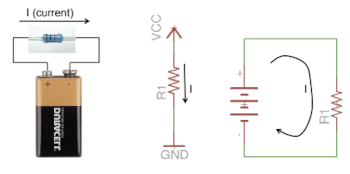
There are 2 type of circuits:

The Multimeter allows you to check if a material is conductive
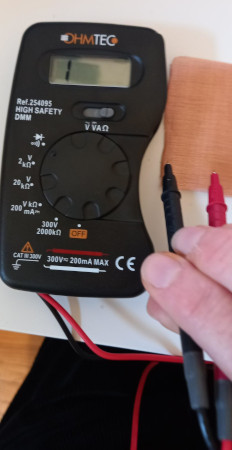
Unity of measure : Voltage or Ampère ???
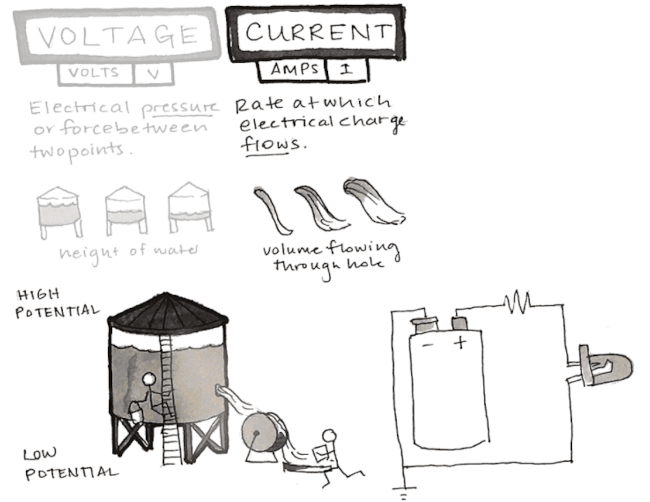
Resistance is the amount of material that resist the flow of the current. It is measured in Ohms
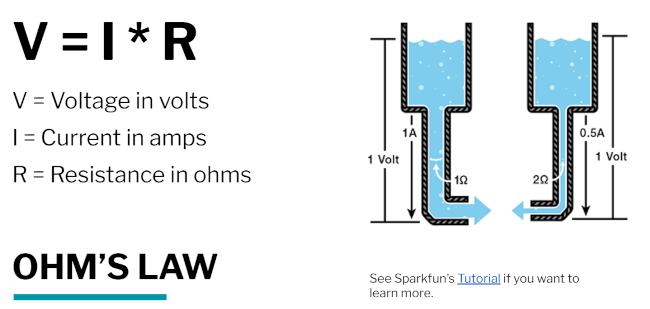
Resistors :
- 2 sides, no matter the orientation
- impede a flow of current and impose a voltage reduction
- is measured in Ohms

Lower is the resistor, higher is the current Higher is the resistor, lower is the current
Led : is a light source. It has a + called Anode and a - called Cathode, so that the current only flows from Cathode to Anode.

Sensors are input, that means information or date that enters a system, like a button press.
2 kinds of sensors : Digital or Analog
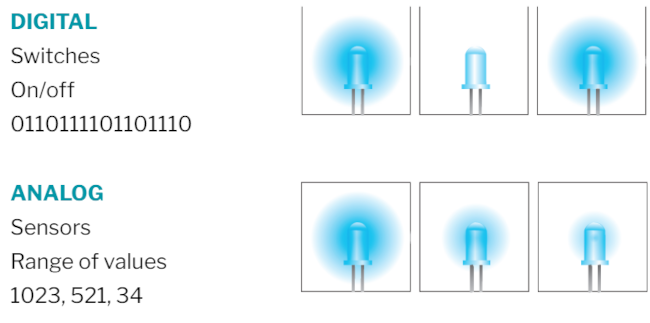
A Switch (Digital) is a break in a circuit :
Exemple : Toggle Switches are two pieces of conductive material together like press, zip... They stay open in one position and closed in the other.
PCB : Printed Circuit Board
Conductive materials¶
List of conductive fabrics or threads on Kobakant
Conductive Yarns
For example, Velostat is a conductive fabric. The more you press on it, the less resistance there will be. Velostat belongs to the analog sensors.

Silver spun with fiber : I discovered that silver spun was used in some fabrics, since it has different properties : >Electro-conductive
Antibacterial Antifungal Anti-smell Thermal regulation Electromagnetic shielding
Those fabrics are usually used as technical fabrics, for their static and bacterial protection properties.
This is an important discovery for me and I will certainely take time to push the subject further on !
!!! Always keep an eye on the DataSheet of the fabric to check its properties abot conductivity !!!
Polysense : Increasing Electrical functionality of a textile, using a process called "in-situ polymerization"
https://counterchemists.github.io/
PolySense, our CHI publication, highlights how – by framing polymerization as a dyeing process – polymerization is a versatile and >easy to deploy tool for creating fabric with custom electrical properties. We also show how to use etching on existing functional >fabric to customize it. The resulting custom fabrics might be used as sensors or conductors and even whole circuits including >sensing elements can be implemented in fabric only.
Experimentating¶
During the Emma's tutorials, we experimented different circuits, from the simpliest to more complex ones, to understand how it works.
Build a circuit¶
First, light a led:
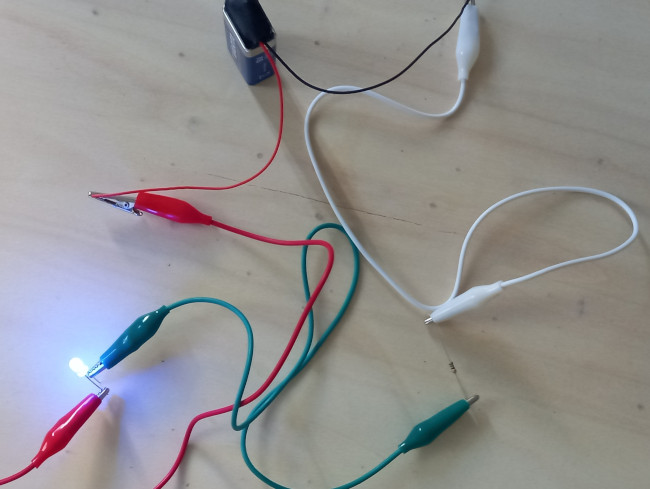
Swatch 1¶
On friday morning, we gathered with Capucine, Julie and Louise to create a swatch that integrate a soft sensor in textile. By the way, Diane had planned to show us how tu use the embroidery machine, so that we could use it through our project.
Material we used :
- Non woven fabric (felt), threads and needles, scissors, scuba
- Conductive material : copper fabric and threads
- Led, 3V battery, multimeter
- Embroidery machine
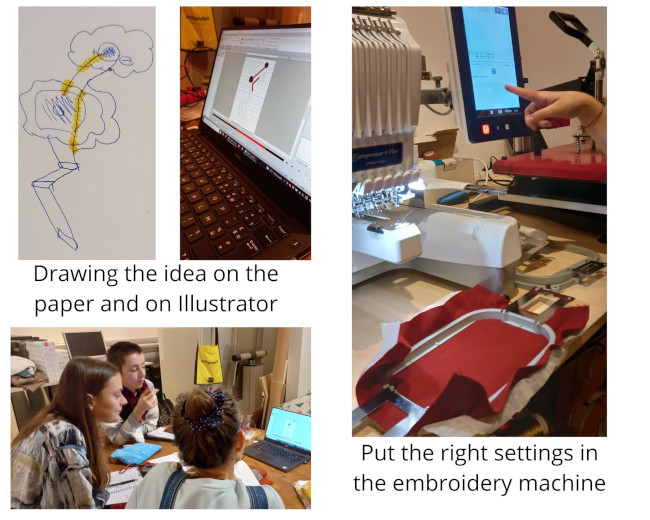
Set up the embroidery machine :
-
You can eather make your draw directly on the Embroidery Machine software or make it for example on Illustrator and send it to the Machine with "wmf" format.
-
You can indicate the machine which way to go. In our case, the order is important to be sure that conductive threads are sometimes hidden and sometimes out to allow the connection
-
Put the threads you need, and relate the colour to the number of thread
Testing that current goes well through our circuit...
It Works !!!
Using Arduino Uno¶
What is Arduino ? Arduino Uno is a boarder for interactive projects It manages and controls the output devices : motors, heating pods, speakers etc...It executes a series of command, one after the other
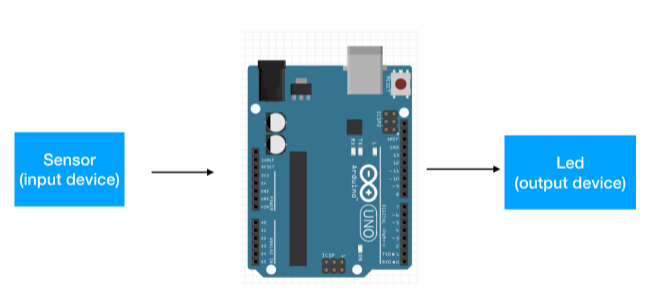
1- Plug Arduino to the laptop
2- Open examples > Basics > Blink
3- Select the Port (tell Arduino which Port you are using) and the Board (here, Arduino Uno)
4- Upload the sketch , here "Blink" ...
| Connecting Arduino | |
|---|---|
| ...if it works, the led embedded on the board blinks | 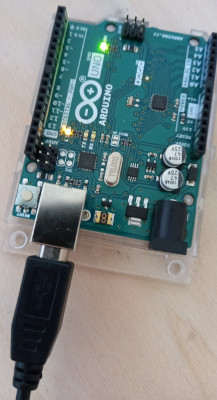 |
With Arduino, we're going to see how to control a led, read a sensor, control a led based on the interaction with a sensor
First, to make a circuit with Arduino, you need :
- a battery
- crocodile clips
- a led
- jumper wire
- and a BreadBoard : it is a physical support for making temporary circuits and prototyping, and require absolutely no soldering

Control a led with Arduino
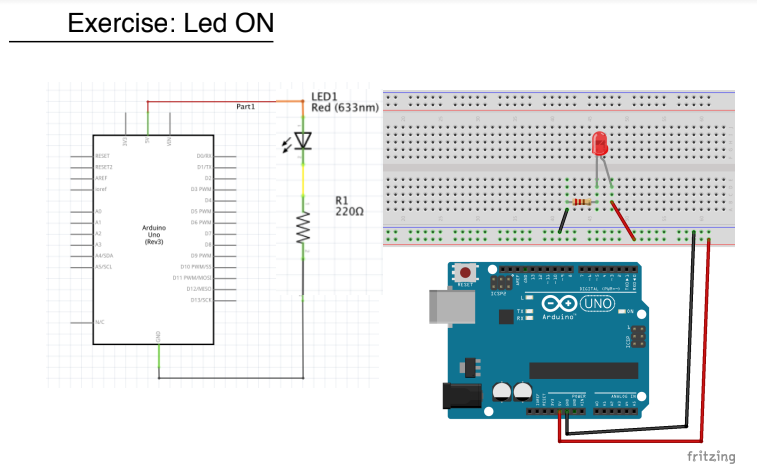
As you can see on this slide :
- the red jumper wire is connected between the 5V power pin of the Arduino and the + red vertical line of the breadboard
- another red wire makes the link with the longer side of the led (which is the +)
- then the current goes into the led
- place a side of the resistor on the same horizontal line of the - branch of the led
- another jumper wire, the black one, will make the link between the resistor and the vertical - lines of the breadboard
- and then, the last jumper wire that connects the - vertical line to the GRD of Arduino, to close the circuit !
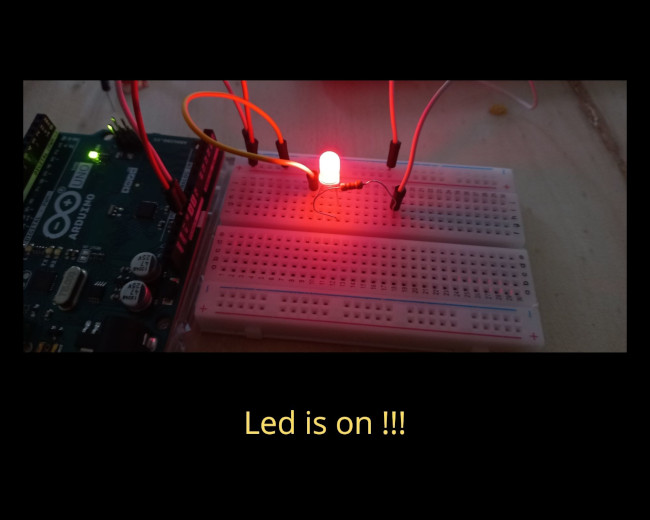
Using the same technic, we made 2 other manipulations :
- Make the led Blink
- Make the led Fade
Some very usefull fonctions to know about, thank you Liza for your very clear slides !!!
- Mapping
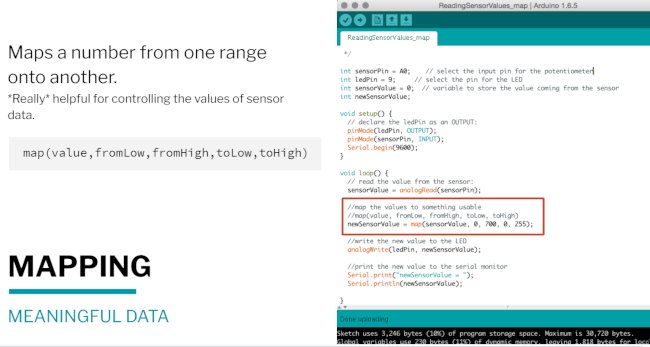
- Constrain
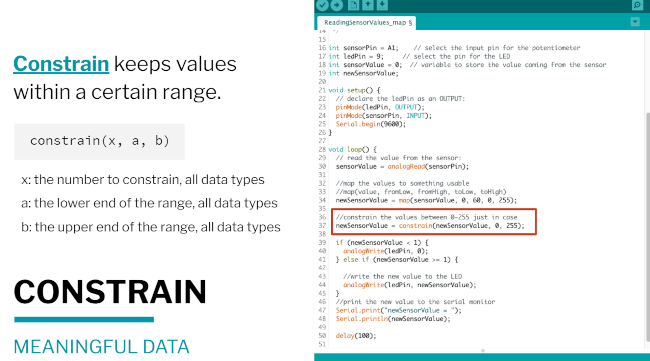
Swatch 2¶
For the second swatch, Diane proposed us to work with a strech conductive fabric :
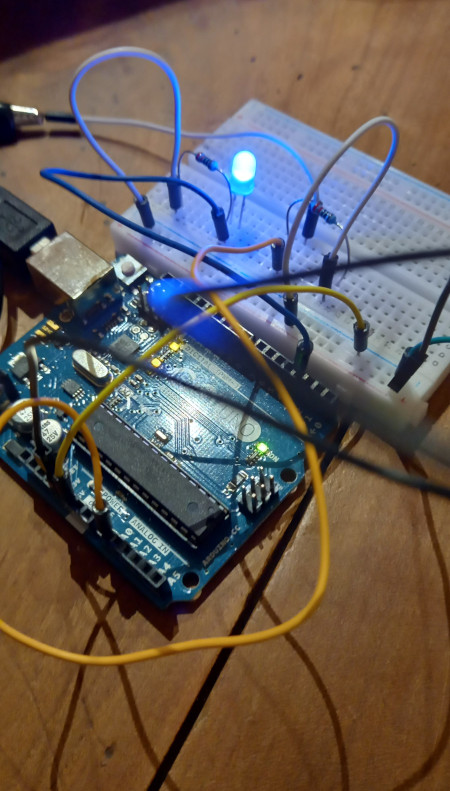
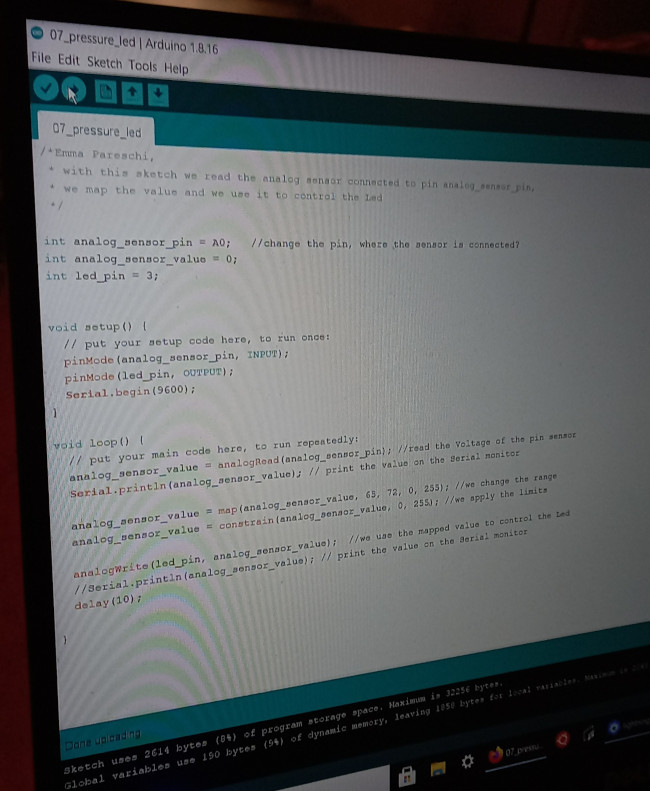
The more you stretch the fabric, the less intense is the light
Other inspiring experiences about sensors¶
(https://www.dx-softlab.com/zine)
Other usefull information¶
Sewing Machines and conductive threads
Inspiration for further experimentation¶
I'm still thinking about what I'd like to do, but maybe I'd like to make a link with energy fields, and the interactivity between human-beings. I think we have still a lot to learn and discover about it and I think it's a really exciting subject !!!